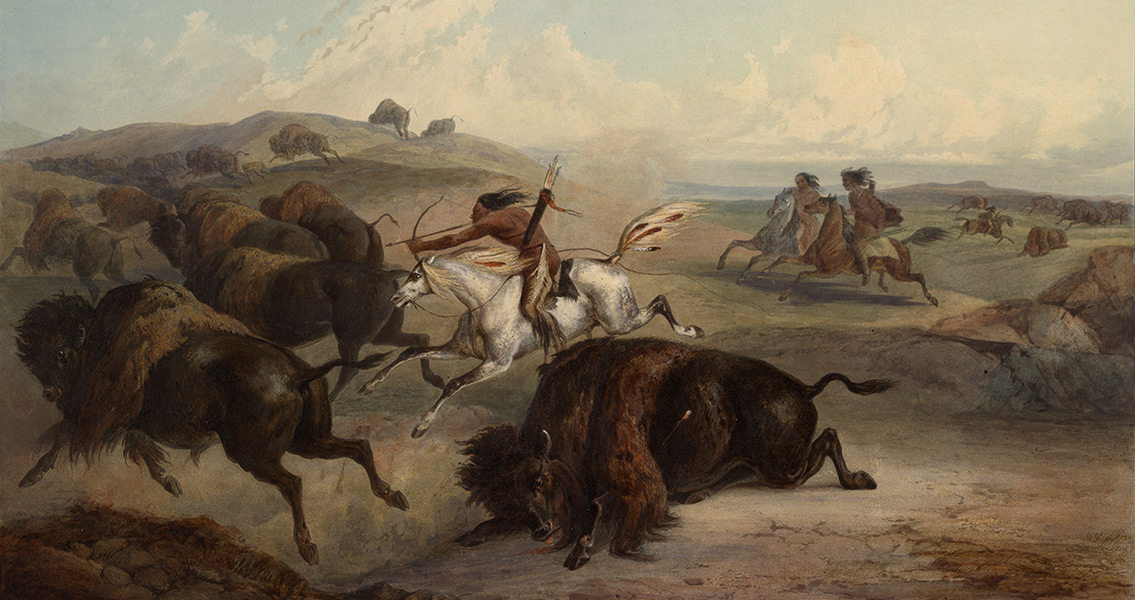The Killing of the Bison
Many years before humans had ever stepped foot on North America, millions of bison(AKA buffalo) roamed the western parts of North America. It is believed that bison arrived in America the same way humans are believed to have arrived: crossing of the Bering Land Bridge. In the early 19th century, however, Bison almost became extinct.This was mainly due to the Westward expansion of white settlers and the forced removal of Native Americans from their homeland. The history of the bison is a very unique one and is intertwined with the history of the Native Americans that lived in North America’s Western Plains.
 |
| According to PBS, Bison weigh up to 2,400 pounds, are up to 6 feet tall and are surprisingly agile with a top speed of 35 mph. |
Native American’s first inhabited the Western Plains because of the abundance of Bison there. They used the Bison for food, clothing, shelter, and many other things. They never wasted any of it. When horses and guns were introduced to the Native hunters by Europeans, hunting of the bison became much easier and in turn expanded their hunting territories greatly. The bison was imperative to the Native’s survival on the plains, so they only took what they needed and cherished each kill. This respect held for the animal by the Native’s is what kept it alive and in abundance for so long.
 |
| *Note that Natives did not hunt bison on horse until Europeans first introduced the horse to them in the 18th century. Image source: New Historian. |
This abundance soon began to decrease in the 19th century. As American settlers started to travel west and squat on native land, they also started to hunt bison. This made sense for them. Bison were an easy food source and had many other valuable uses. These settlers noticed how imperative the bison were to the Native tribes and so did the U.S. army, who was tasked with removing them from their homes. The ‘Plains Indian Wars’ was a war in which the U.S. army basically just tried to remove Plains Indians from their homes. The U.S. found themselves struggling to defeat the Native Americans because of the bison. The Natives were able to outmaneuver the American’s and survive off of the abundance of bison in the area.
According to History.com, Captain Fetterman, a United States Captain during the Plains Indian War, boasted that “With 80 men I could ride through the whole Sioux Nation.”. The captains boast was heard by the United states and he got his chance. In 1866 at a battle near Fort Laramie, Captain Fetterman and his 80 men were lead into an ambush by the Native people’s. All 81 men were slaughtered by the Natives and this upset was considered one of the Army’s greatest defeats on the plains. After this slaughter, the United States realized they needed new tactics to defeat the Native Americans.
The Army looked back on their counter insurgent tactics used for the removal of other Native American tribes and the tactics used during the civil war to learn how to force the Native’s onto their reserved lands. They studied these tactics and learned that they had to take out the Native’s greatest piece of Infrastructure: the bison. A quote from Colonel Dodge, one of the men who first proposed this tactic was “Every buffalo dead is an Indian gone,...”.
| A mound of bison hide. Image taken from the Smithsonian Magazine. |
It was not feasible for the Army to kill the millions of bison alone, so they allowed the settlers to stay at their forts and hunt all of the bison in the region. To further the destruction of the bison, its hide also began being used as a cheap alternative to expensive leather. As more and more bison were killed, the Natives were forced to stop living their nomadic lifestyle and give up their lands. They could no longer use the bison as a means of living and Americans were not selling them cattle. These two factors eventually forced the Natives to give in and move to the reservation.
Today, there are more than 500,000 buffalo roaming the American West. Many of them are hybrids with cattle and even fewer are actually wild but there are many organizations working to defend them and their populations should continue growing in the future
Sources:
This source provided me with background information on the importance of Bison in Native American culture.
https://www.pbs.org/buffalowar/buffalo.html
This source inspired me to do more research on the topic.
https://www.lcps.org/cms/lib/VA01000195/Centricity/Domain/10442/Native%20American%20Notes.pdf
This source provided me with many different aspects of the killing of the Bison and how it affected natives.
https://newsmaven.io/indiancountrytoday/archive/genocide-by-other-means-u-s-army-slaughtered-buffalo-in-plains-indian-wars-nEWiK2AZik-yWbnFLXOqfw/
This source talks about the Fetterman Massacre.
https://www.history.com/this-day-in-history/indians-massacre-fetterman-and-eighty-soldiers
https://www.history.com/this-day-in-history/indians-massacre-fetterman-and-eighty-soldiers

Comments
Post a Comment